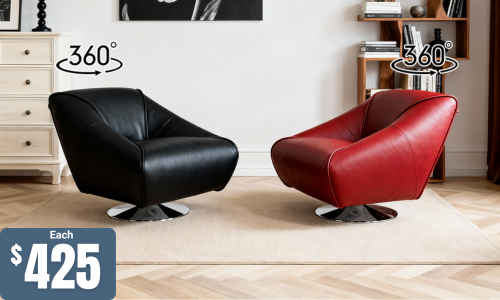Posts tagged with 'space optimization'

When it comes to making your home a cosy and inviting space, the way you arrange your furniture can make all the difference. Whether you’re moving into a new home or refreshing a current space, thoughtful furniture placement not only enhances comfort but also maximises functionality. Here’s how you can arrange your furniture for the best possible comfort while making the most of your living space.
- Understand the Flow of the Room
Start by understanding the natural flow of your room. Pay attention to the main entry points, windows, and pathways. The goal is to arrange your furniture in a way that promotes easy movement and conversation without obstructing walkways.
- Pro Tip: Leave at least 60-90 cm between furniture pieces to ensure a comfortable flow of movement.
- Create zones: In open-plan spaces, divide the area into zones (e.g., living area, reading nook, dining space) to ensure comfort and purpose in each section.
- Prioritize Functionality
Think about how the room is going to be used. Are you arranging a living room primarily for family movie nights, or do you want it to be more suitable for hosting guests? Consider the function of each piece of furniture and how it fits into the overall design of the room.
- Living Room: If the TV is a focal point, make sure your seating is arranged to face it comfortably. For conversation-focused spaces, opt for a U-shaped or circular seating arrangement.
- Bedroom: Place the bed as the central piece of furniture. Position it against a solid wall to create a sense of balance and comfort.
- Consider Visual Balance
Achieving visual balance in a room enhances both aesthetics and comfort. Balance involves distributing the weight of furniture and décor evenly throughout the space, so one side doesn’t feel too “heavy” compared to the other.
- Even Distribution: If you have a large, heavy sofa on one side of the room, balance it out by placing other substantial pieces, like a bookshelf or an accent chair, on the opposite side.
- Height Variation: Mix furniture of varying heights to create depth. A low coffee table paired with a tall floor lamp or a high-backed chair next to a lower sofa creates a balanced look.
By keeping balance in mind, you’ll avoid awkwardly empty spaces or overcrowded areas, ensuring a visually harmonious and comfortable environment.
- Balance Style and Comfort
When it comes to comfort, it’s essential to find the right balance between aesthetics and functionality. It’s tempting to opt for trendy furniture, but remember that comfort should be a top priority.
- Choose comfortable seating: Invest in furniture that offers ample support, especially for frequently used areas like the living room or home office.
- Layer with accessories: Incorporate cushions, throws, and area rugs to add layers of coziness to your furniture arrangement without sacrificing style.
- Mind the Scale of Your Furniture
Scale and proportion play a crucial role in creating a comfortable space. Oversized furniture in a small room can make it feel cramped, while tiny pieces in a large space may leave it feeling sparse and uninviting.
- Small Spaces: Opt for multi-functional furniture like a sofa bed or nesting tables that maximise space without cluttering the room.
- Large Rooms: Use larger furniture like sectional sofas or oversized armchairs to fill the space and make it feel more inviting.
- Symmetry vs. Asymmetry
Symmetry in furniture arrangement often creates a more formal, balanced feel, while asymmetry can add a dynamic and casual vibe to the space. Play around with different arrangements to see what feels most comfortable for your needs.
- Symmetry: Placing identical chairs on either side of a coffee table can create a balanced look in your living room.
- Asymmetry: You can add a touch of creativity by mixing different furniture styles or playing with varied heights and angles for a more eclectic, cosy vibe.
- Lighting and Ambiance
Proper lighting plays a big role in comfort. Use a combination of ambient, task, and accent lighting to create a well-lit and cosy atmosphere.
- Ambient Lighting: This is your main light source, often from ceiling fixtures or recessed lighting.
- Task Lighting: For reading or working, consider lamps or adjustable light fixtures that provide focused illumination.
- Accent Lighting: Use floor lamps, candles, or dimmable lights to create a warm, inviting ambiance.
- Leave Breathing Room
Avoid overcrowding your space with too much furniture. Less is often more when it comes to comfort. Having space between furniture pieces creates a sense of openness and can make your home feel more relaxed.
- Pro Tip: Give larger pieces of furniture (like sofas and dressers) about 30 cm of space from the walls to avoid a cramped feel.
- Test and Adjust
Once your furniture is in place, live in the space for a while to see how it feels. Don’t be afraid to rearrange until you find the perfect balance of comfort and practicality.
- Try shifting furniture angles slightly to create a cozier and more inviting look.
- Rearrange smaller accessories like side tables, plants, or ottomans to add to the overall comfort and flow of the room.
Final Thoughts
Arranging furniture for maximum comfort is about finding the right balance between functionality, style, and the natural flow of your home. It’s not just about how things look, but how they feel and work for your daily life. By considering space, balance, lighting, and function, you can create a comfortable, inviting atmosphere where you’ll love spending time.

Open-plan homes have become increasingly popular in recent years, offering a sense of spaciousness, natural light, and enhanced social interactions. With the absence of walls dividing different living spaces, designing the furniture layout becomes crucial to create a harmonious and functional environment. In this article, we will explore some effective tips and strategies for arranging furniture in open-plan homes to achieve seamless transitions between various areas.
Define Zones
The first step in furniture arrangement for open-plan homes is to define distinct zones within the space. While there may not be physical barriers, you can use furniture and area rugs to visually separate different areas such as the living room, dining area, and kitchen. Each zone should have a specific purpose and flow naturally into the next, ensuring a smooth transition between spaces.
Consider Traffic Flow
One of the key challenges in open-plan homes is managing traffic flow. To maintain a seamless transition, it is essential to keep pathways clear and unobstructed. Avoid placing large furniture pieces in the middle of the room, and position them against walls or the edges of designated zones. This allows people to move freely and creates a sense of openness.
Use Cohesive Design Elements
To create a cohesive and unified look, incorporate design elements that tie the different zones together. Choose a consistent colour palette and style for your furniture, decor, and accessories. This doesn't mean everything has to match perfectly, but having some common elements will help achieve a harmonious overall design.
Consider Sight Lines
In open-plan homes, sight lines play a crucial role in shaping how the space is perceived. Arrange furniture in a way that allows for easy sight lines between different zones. For example, if you are sitting on the sofa in the living area, ensure that you have a clear view of the dining area and kitchen. This fosters a sense of connection between spaces and encourages social interactions.
Scale and Proportion
When choosing furniture for open-plan spaces, pay close attention to scale and proportion. Oversized furniture can overwhelm the room, while too many small pieces can make it feel cluttered. Strive for a balanced mix of furniture sizes that fit well within each zone and complement the overall room size.
Utilise Area Rugs
Area rugs are excellent tools for defining specific zones in open-plan homes. They not only add warmth and texture to the space but also visually separate different areas. Make sure the size of the rug complements the furniture arrangement within each zone, anchoring the pieces together.
Flexibility and Mobility
Open-plan living allows for flexible furniture arrangements, making it easier to adapt the space for various activities and occasions. Consider incorporating furniture with wheels or lightweight pieces that can be easily moved and rearranged to accommodate different needs and gatherings.
Embrace Multifunctional Furniture
In open-plan homes, optimising space is essential. Embrace the concept of multifunctional furniture, such as a dining table that can extend into a workspace or a sofa with hidden storage. These pieces help maximise the usability of the space while maintaining a seamless transition between areas.
Designing furniture arrangements for open-plan homes requires a thoughtful approach to create seamless transitions between different zones. By defining zones, considering traffic flow, using cohesive design elements, and being mindful of sight lines, scale, and proportion, you can achieve a harmonious and functional space that enhances your home's overall appeal. Embrace the versatility of open-plan living, and let your furniture layout reflect your lifestyle and preferences, making it a true reflection of your unique style.
Check out our products!




.jpeg)

 (3).jpeg)
